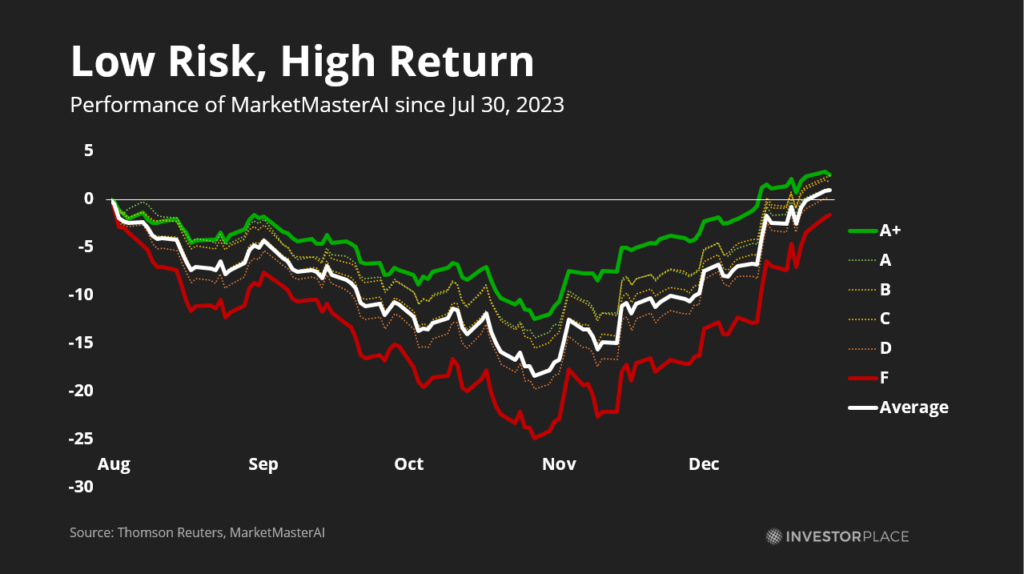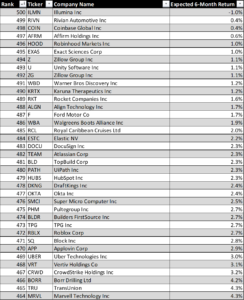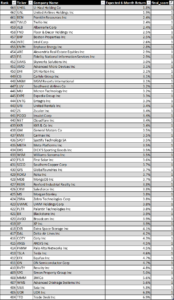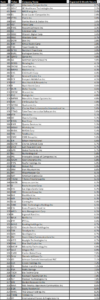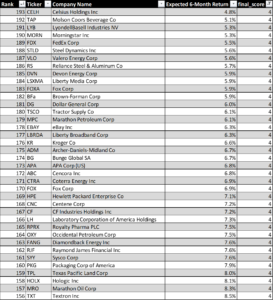In July, I created MarketMasterAI, a powerful AI tool to help investors pick winning stocks. Its simulated historic performance was excellent. “A+” rated companies performed 4x better than “F” rated ones, and $10,000 invested in the model since 2010 would have grown to over $50,000, easily beating the market average.
But would such simulations work well in the real world?
It turns out the answer is “yes.”
Even without rebalancing, MarketMasterAI’s 199 “A+” rated stocks outperformed the market with both less risk and higher return. It’s the best of both worlds.
Meanwhile, even the recent junk rally wasn’t enough to help “F” graded stocks dig out of their hole. These low-rated stocks continue to trail the “A+” ones by 4.2% through December. (They lagged by as much as 14.5% at the end of October). Though this might not sound like much, compounding a 4.2% divergence over a decade is the difference between turning $10,000 into $50,000 versus just $18,900!
Why Does MarketMasterAI Work?
MarketMasterAI is willing to change tactics as it “sees” new information. During the Covid-19 pandemic, the system’s simulations began picking out lower-quality stocks that benefited from government stimulus checks and the Fed’s loose monetary policy. At one point, unprofitable Bitcoin miner Marathon Digital Holdings (NASDAQ:MARA) even became a top pick.
As stimulus checks began to dry up, MarketMasterAI pivoted to growth companies like Tesla (NASDAQ:TSLA) and Chipotle (NYSE:CMG) in 2021 before turning to blue chips by the end of 2022. By the time it was making real-life predictions in July, the system had turned to cash-generating firms like Lululemon (NYSE:LULU) (+32%) and Costco (NASDAQ:COST) (+22%) to help ride out a volatile market.
In other words, I designed MarketMasterAI so it has no preconception of what’s “good” or “bad” in a stock besides its risk and return. If beaten-down penny stocks can consistently generate outperformance, then so be it. We’re buying busted SPACs and failed biotechs. But if quality and growth matter more, then we’re switching tactics.
The system is also able to detect patterns across multiple industries. So, if it sees analyst estimates at companies like Walmart (NYSE:WMT) and Target (NYSE:TGT) begin to fall, it will know to de-emphasize consumer cyclical stocks that suffer when consumer budgets tighten. It might not know why it’s making a certain decision. But it’s enough to produce a list of stocks that, on average, will outperform the market.
That makes MarketMasterAI a powerful tool. An investor picking only “A+” rated stocks will outperform, even if they choose companies from the pool randomly. And by avoiding the “F” rated ones, they’re essentially passing a test by removing all wrong answers.
It’s like playing at a casino where the odds are stacked in your favor. Play for long enough, and you’re bound to come out ahead.
The 500 To Stocks to Buy for 2024: 464-500 (F-Grade)
Only 37 of the top 500 companies by market capitalization earn the lowest “F” grade score.
Still, these firms stand out as being less profitable than their peers. On average, F-rated stocks earn -3.6% return on assets (ROA) and -9% return on invested capital (ROIC) , versus 6.5% and 9.3%, respectively. They have also seen extremely high recent returns, which tend to be followed by pullbacks. On average, this group has seen shares rise 40% in the past two months.
Most worryingly, growth estimates for these F-rated stocks are falling. Analysts now expect the companies to grow sales by only 62%, down from 80% three months ago.
Together, that means these firms will likely become “growth traps” in 2024, where lofty expectations are met with eventual disappointment. The system recommends investors stay away from high-risk companies like Rivian Automotive (NASDAQ:RIVN) and Robinhood Technologies (NASDAQ:HOOD)
404-463 (D-Grade)
The next group of top 500 stocks have slightly better profitability characteristics than F-graded ones. The ROA is a positive 3.8% and ROIC is 5.7%.
However, these companies lack the same high-growth characteristics of their F-rated peers. D-rated firms have 10.3% expected revenue growth rate — not much different from the market. They’re also highly indebted as a group, with debt-to-equity ratios exceeding 240%.
Together, that creates a relatively forgettable cohort of stocks that includes firms like Skyworks Solutions (NASDAQ:SWKS), Southwest Airlines (NYSE:LUV) and Morgan Stanley (NYSE:MS). Investors should also note that the list includes several tech stocks like Palantir Technologies (NYSE:PLTR) and Advanced Micro Devices (NASDAQ:AMD) where fundamentals are beginning to lag behind the hype.
312-403 (C-Grade)
The C-grade group, unsurprisingly, looks like a slightly worse-than-average version of the broader stock market. Companies in this group have ROAs and ROICs of 5.5% and 8.2%, respectively (versus 6.5% and 9.3% market average). They are also slower-growing and pricier than the average company.
There are some outliers. Despite its rapid growth, Nvidia (NASDAQ:NVDA) only scores a “C”; valuations have simply become too rich to support more than a 5% upside over the next six months. Others like Paycom (NYSE:PAYC) have fallen so far (down 33% in the past six months) that MarketMasterAI hesitates to award a better score.
However, the average “C-rated” firm looks more like Tyson Foods (NYSE:TSN) and Stanley Black & Decker (NYSE:SWK) — firms that aren’t necessarily “bad.” Just more forgettable than anything else.
194-311 (B-Grade)
Our list of B-grade stocks looks progressively better than previous groups. ROA and ROIC now sit at 8.0% and 10.6%, and cash positions are far stronger. The average firm here pays out 39% of its net income as dividends.
Some companies also have strong growth outlooks. Analysts believe that firms like Pifzer (NYSE:PFE) and LiveNation (NYSE:LYV) could see earnings per share surge 30% or more in 2024. And others like HP (NYSE:HP) are riding surprising growth cycles.
However, most of these firms have limited upside, which caps their scores. The firm with the highest expected return is Pure Storage (NYSE:PSTG), a firm that analysts believe will grow revenues at just 2.6% in the coming year. Even Pfizer and LiveNation have limited potential, given their maturity.
These B-rated stocks are certainly investable. But save your dry powder for something better.
156-193 (A-Grade)
Our list of A-grade stocks now looks compelling. Earnings are high (ROA of 9% and ROIC of 14%), and cash flow is strong. The average A-rated firm distributed 43% of its net income as dividends in the past year.
Momentum is also relatively good at these firms. The average A-rated company has risen 14% over the past three months. This moderate pace (unlike the rapid version seen by F-rated stocks) tends to signal greater gains to come. And valuations are excellent; the average A-rated stock trades at 15 times forward earnings, well below the average of 25X.
The tradeoff is growth. The average A-grade firm is only expected to see a 3% increase in sales and 2% rise in net income in 2024 — well below market averages. That means investors are buying sleepy blue-chips without hypergrowth potential.
Short interest in these firms is also surprisingly high, which could signal general bearishness to these money-spinning franchises. Companies like Tractor Supply (NASDAQ:TSCO) and Occidental Petroleum (NYSE:OXY) have 5% or more of their free float sold short. These companies are high-quality, but we know from history that quality doesn’t always matter in the short run.
1-192 (A+ Grade)
Finally, the list of “A+” rated stocks is unusually large this month, signaling that MarketMasterAI is now favoring large-cap stocks. (The bottom-2500 Russell 3000 stocks contain the majority of lower grades).
It’s easy to see why. Analysts estimate that these top companies will see 14.7% net income growth next year, far outpacing other firms. Wall Street has also kept growth estimates relatively steady at these top companies. (Lower-graded firms have seen enormous cuts over the past quarter).
This makes sense from a top-down standpoint. The rise of artificial intelligence favors incumbents since AI models require enormous amounts of data (and capital investment) to train. That means big companies will likely outperform smaller ones.
Higher borrowing costs also favor large firms that have access to better financing. They also need less of it; A+ firms have 20% less debt than the average company.
Together, that means firms like Deere & Co (NYSE:DE), Apple (NASDAQ:AAPL) and Gilead Sciences (NASDAQ:GILD) all earn A+ scores this month. These are market leaders, and history tells us that they’re the safest bets in periods where analysts are slashing expectations for the next year.
3 Stocks to Buy for 2024
The top three companies recommended by MarketMasterAI this month all share quality-growth characteristics.
- Mastercard (NYSE:MA). 13.4% expected return. Analysts expect the payments firm to grow revenues by 12.1% and earnings per share by 17% in 2024 as lucrative cross-border transactions return. Credit losses are also expected to remain low — a winning combination for a credit card company.
- Verisk Analytics (NASDAQ:VRSK). 13.4% expected return. This wide-moat data analytics company is an essential piece of the insurance industry. The company has a proprietary insurance database of over 16 million commercial properties, making it the leader in catastrophe modeling for insurers, financial institutions and governments. A steady increase in analyst estimates this year also sets the stage for a strong 2024.
- TJX Companies (NYSE:TJX). 13.0% expected return. Though shares are relatively expensive, TJ Maxx has earned that premium by building around 50% market share in the off-price apparel industry. Analysts believe TJX can grow its footprint from 2,600 stores today to around 3,000 over the next decade. A consumer shift towards lower-cost options in 2024 could further boost results.
These three firms represent a bet on a moderate return to consumption in 2024. Consumers will likely start traveling more, as evidence from airline bookings suggests. But they will also pay more attention to what they buy. Earlier this year, Louis Vuitton (LVMH) sounded the alarm on luxury demand.
That means investors should focus on companies that either cater to these penny-pinching customers or on bets like Verisk that run independently from consumer demand. Either way, MarketMasterAI is warning us to keep our bets conservative for what seems to be a volatile 2024.
On the date of publication, Thomas Yeung held long positions in GM, PYPL, GOOG, and GOOGL. The opinions expressed in this article are those of the writer, subject to the InvestorPlace.com Publishing Guidelines.

